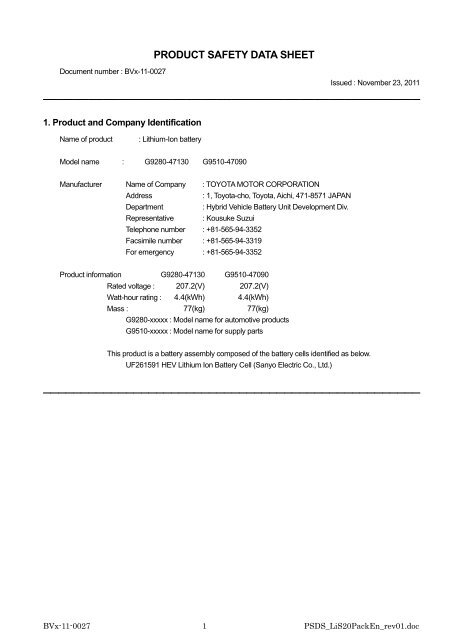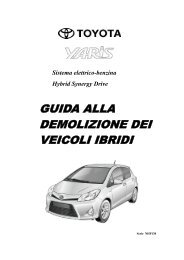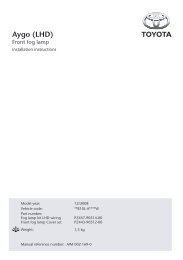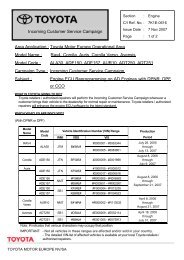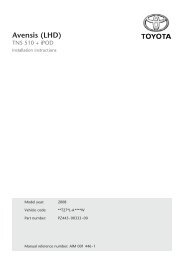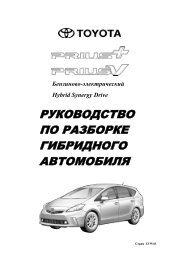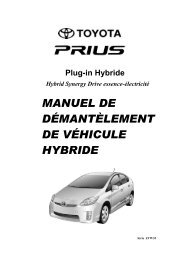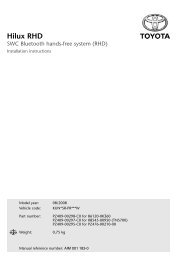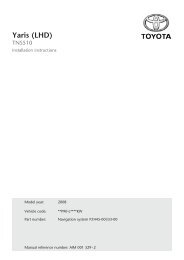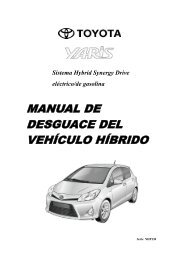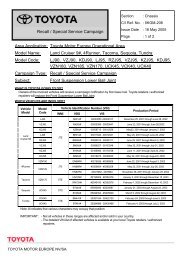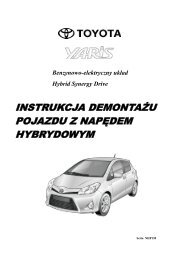PRODUCT SAFETY DATA SHEET - Toyota-tech.eu
PRODUCT SAFETY DATA SHEET - Toyota-tech.eu
PRODUCT SAFETY DATA SHEET - Toyota-tech.eu
Create successful ePaper yourself
Turn your PDF publications into a flip-book with our unique Google optimized e-Paper software.
<strong>PRODUCT</strong> <strong>SAFETY</strong> <strong>DATA</strong> <strong>SHEET</strong><br />
Document number : BVx-11-0027<br />
Issued : November 23, 2011<br />
━━━━━━━━━━━━━━━━━━━━━━━━━━━━━━━━━━━━━━━━━━━━━━━━━━<br />
1. Product and Company Identification<br />
Name of product<br />
: Lithium-Ion battery<br />
Model name : G9280-47130 G9510-47090<br />
Manufacturer Name of Company : TOYOTA MOTOR CORPORATION<br />
Address<br />
: 1, <strong>Toyota</strong>-cho, <strong>Toyota</strong>, Aichi, 471-8571 JAPAN<br />
Department<br />
: Hybrid Vehicle Battery Unit Development Div.<br />
Representative : Kousuke Suzui<br />
Telephone number : +81-565-94-3352<br />
Facsimile number : +81-565-94-3319<br />
For emergency : +81-565-94-3352<br />
Product information G9280-47130 G9510-47090<br />
Rated voltage : 207.2(V) 207.2(V)<br />
Watt-hour rating : 4.4(kWh) 4.4(kWh)<br />
Mass : 77(kg) 77(kg)<br />
G9280-xxxxx : Model name for automotive products<br />
G9510-xxxxx : Model name for supply parts<br />
This product is a battery assembly composed of the battery cells identified as below.<br />
UF261591 HEV Lithium Ion Battery Cell (Sanyo Electric Co., Ltd.)<br />
━━━━━━━━━━━━━━━━━━━━━━━━━━━━━━━━━━━━━━━━━━━━━━━━━━<br />
BVx-11-0027 1 PSDS_LiS20PackEn_rev01.doc
2. Composition / Information on Ingredients<br />
The batteries consist of hermetically sealed lithium ion cells that contain a number of chemicals and materials of<br />
construction. However, under normal conditions of use there is no risk of exposure.<br />
・Information about the chemical nature of product:<br />
Common chemical name/ CAS number<br />
General name<br />
NIOSH / RTECS<br />
number<br />
Concentration /<br />
Concentration range<br />
Lithium Metal Oxide None listed None listed 15~25%<br />
Aluminum 7429-90-5 BD0330000 20~30%<br />
Graphite 7782-42-5 FF5250100 5~15%<br />
Copper 7440-50-8 GL5325000 10~20%<br />
Organic electrolyte None listed None listed 15~25%<br />
・Hazardous Materials Category of organic electrolyte:<br />
Category IV (Inflammable liquids)-Class II petrol<strong>eu</strong>m in Japanese fire service law<br />
━━━━━━━━━━━━━━━━━━━━━━━━━━━━━━━━━━━━━━━━━━━━━━━━━━<br />
3. First Aid Measures<br />
The product contains organic electrolyte.<br />
Only a small amount may leak from the batteries which may irritate the eyes, nose, throat, and skin.<br />
Inhalation<br />
Skin contact<br />
Eye contact<br />
Ingestion<br />
: - Contact with the vapor of the electrolyte may irritate nose and throat. In severe cases<br />
such as confined spaces, move exposed patients to a well ventilated area and seek<br />
medical treatment.<br />
: - Take up with cloth.<br />
- Wash the contact areas off immediately with plenty of water and soap or skin cleaner.<br />
Take medical treatment if pain stimulation or a skin reaction occurs.<br />
- Immediately remove contaminated clothing.<br />
: - Immediately flush eyes with plenty of clean water for at least 15 minutes, holding eyelids<br />
open while flushing.<br />
- Take medical treatment immediately.<br />
: - Take a medical treatment immediately.<br />
- If vomiting occurs naturally, avoid aspiration.<br />
- Do NOT induce vomiting, unless instructed by the doctor.<br />
━━━━━━━━━━━━━━━━━━━━━━━━━━━━━━━━━━━━━━━━━━━━━━━━━━<br />
4. Fire Fighting Measures<br />
Extinguishing method : Since vapor, generated from burning batteries may make eyes, nose and throat irritate,<br />
be sure to extinguish the fire on the windward side.<br />
Fire extinguishing agent : Plenty of water and alcohol-resistant foam are effective.<br />
Protective clothing : SCBA, safety goggles if not part of the SCBA, full personal protective clothing, and<br />
gloves suitable for organic solvents.<br />
━━━━━━━━━━━━━━━━━━━━━━━━━━━━━━━━━━━━━━━━━━━━━━━━━━<br />
BVx-11-0027 2 PSDS_LiS20PackEn_rev01.doc
5. Measures for electrolyte leakage from the battery<br />
- Take up with dry absorbent cloth.<br />
- Move the battery away from the ignition source to open area.<br />
Protective clothing<br />
: Gas mask for organic gases, safety goggle, safety glove suitable for organic solvents.<br />
━━━━━━━━━━━━━━━━━━━━━━━━━━━━━━━━━━━━━━━━━━━━━━━━━━<br />
6. Precaution for Handling and Storage<br />
Handling<br />
Storage<br />
- To prevent serious injury or death, do not remove the cover of battery assembly.<br />
- Do not let water penetrate into packaging boxes during their storage and transportation.<br />
- The batteries will be stored at room temperature, charged to about 30-50% of capacity.<br />
- Do not store the battery in places of the high temperature or under direct sunlight for a long time<br />
or in front of a stove. Please also avoid the places of high humidity. Be sure not to expose the<br />
battery to condensation, water drop.<br />
━━━━━━━━━━━━━━━━━━━━━━━━━━━━━━━━━━━━━━━━━━━━━━━━━━<br />
7. Exposure Controls / Personal Protection<br />
Under normal conditions release of ingredients does not occur. In the event of release of ingredients, the<br />
information of the ingredients is as follows.<br />
・Control parameters<br />
Common chemical<br />
OSHA<br />
ACGIH<br />
name / General name PEL-TWA TLV-TWA BEI<br />
Lithium Metal Oxide None listed None listed None listed<br />
Aluminum<br />
15 mg/・ (as total dust) 10 mg/・ (as total dust) None listed<br />
5 mg/・<br />
(as respirable fraction)<br />
Graphite 15 mg/・ (as total dust) 10 mg/・<br />
None listed<br />
(as inhalation coarse<br />
particulate)<br />
Copper<br />
1 mg/・ (as dust, mist) 1 mg/・ (as dust, mist) None listed<br />
0.1 mg/・ (as fume)<br />
0.2 mg/・ (as fume)<br />
Organic electrolyte None listed None listed None listed<br />
OSHA: Occupational Safety and Health Administration<br />
PEL-TWA: Permissible Exposure Limit-Time Weighted Average concentration<br />
ACGIH: American Conference of Governmental Industrial Hygienists, Inc.<br />
TLV-TWA: Threshold Limit Value-Time Weighted Average concentration<br />
BEI:Biological Exposure Indices<br />
(in case of electrolyte leakage from the battery)<br />
Acceptable concentration : Not Specified in ACGIH. (1)<br />
Facilities<br />
: The storage place should be well ventilated, such as using local ventilator.<br />
Protective clothing : Gas mask for organic gases, safety goggle, safety glove for organic solvents.<br />
━━━━━━━━━━━━━━━━━━━━━━━━━━━━━━━━━━━━━━━━━━━━━━━━━━<br />
BVx-11-0027 3 PSDS_LiS20PackEn_rev01.doc
8. Toxicology Information<br />
There is no data available on the product itself. The information of the internal cell materials is as follows.<br />
Lithium Metal Oxide<br />
・Acute toxicity: Unknown<br />
・Local effects: Unknown<br />
・Sensitization: Unknown<br />
・Chronic toxicity/Long term toxicity: Unknown<br />
・Skin causticity: Unknown<br />
Aluminum<br />
・Health Rating:0 - None<br />
・Flammability Rating:1 - Slight<br />
・Reactivity Rating:1 - Slight<br />
・Contact Rating:0 - None<br />
・Local effects: Aluminum itself has no toxicity.<br />
Graphite<br />
・Health Rating:0 - None<br />
・Flammability Rating:0 - None<br />
・Reactivity Rating:0 - None<br />
・Contact Rating:1 - Slight<br />
・Acute toxicity: Unknown.<br />
・Local effects: When it goes into one’s eyes, it stimulates one’s eyes; conjunctivitis, thickening of corneal<br />
epithelium or edematous inflammation palpebra may be caused.<br />
・Chronic toxicity/Long term toxicity: Since the long-term inhalation of high levels of graphite coarse<br />
particulate may become a cause of a lung disease or a tracheal disease.<br />
・Carcinogenicity: Graphite is not recognized as a cause of cancer by research organizations and natural<br />
toxic substance research organizations of cancer.<br />
Copper<br />
・Health Rating:3 - Severe (Life)<br />
・Flammability Rating:1 - Slight<br />
・Reactivity Rating:2 - Moderate<br />
・Contract Rating:1 - Slight<br />
・Acute toxicity:<br />
60-100mg sized coarse particulate causes a gastrointestinal disturbance with nausea and inflammation.<br />
TDL 0 , hypodermic - Rabbit 375mg/kg<br />
・Local effects:<br />
Coarse particulate stimulates a nose and a tracheal.<br />
When it goes into one’s eyes, the symptom of the reddening and the pain is caused.<br />
・Sensitization: Sensitization of the skin may be caused by long-term or repetitive contact.<br />
・Reproductive toxicity: TDL 0 , oral - Rat 152mg/kg<br />
Organic electrolyte<br />
・Acute toxicity: LD 50 , oral - Rat 2,000mg/kg or more<br />
・Local effects: Unknown.<br />
・Skin irritation study: Rabbit - Mild<br />
・eye irritation study: Rabbit - Very severe<br />
━━━━━━━━━━━━━━━━━━━━━━━━━━━━━━━━━━━━━━━━━━━━━━━━━━<br />
BVx-11-0027 4 PSDS_LiS20PackEn_rev01.doc
9. Ecological Information<br />
・Persistence/degradability: Since a battery cell and the internal materials remain in the environment,<br />
do not bury or throw out into the environment.<br />
━━━━━━━━━━━━━━━━━━━━━━━━━━━━━━━━━━━━━━━━━━━━━━━━━━<br />
10. Disposal Considerations (Precautions for recycling)<br />
- When the battery is worn out, dispose of it under the ordinance of each local government or the law issued by<br />
relating government.<br />
- Disposal of the worn-out battery may be subjected to Collection and Recycling Regulation.<br />
━━━━━━━━━━━━━━━━━━━━━━━━━━━━━━━━━━━━━━━━━━━━━━━━━━<br />
11. Transportation Information<br />
- This product is classified as lithium ion batteries UN3480. During the transportation of the battery, it should be<br />
subjected to the regulations on the transportation below.<br />
- IATA (International Air Transport Organization) : Dangerous Goods Regulations 52nd Edition<br />
Effective 1 January 2011<br />
- IMO (International Maritime Organization) : International Maritime Dangerous Goods (IMDG) Code<br />
2010 Edition (Amendment 35-10)<br />
- Applicable national regulations such as the USA’s hazardous materials regulations (49 CFR 173.185).<br />
- Hazard Classification : Class 9 Miscellaneous<br />
- UN Number : 3480<br />
- Proper Shipping Name : Lithium ion batteries<br />
- Packing Group : II (depending on mode of transport and international location)<br />
- This product is adapted to Recommendations on the TRANSPORT OF DANGEROUS GOODS Manual of Tests<br />
and Criteria Fifth revised edition (UN : United Nations)<br />
━━━━━━━━━━━━━━━━━━━━━━━━━━━━━━━━━━━━━━━━━━━━━━━━━━<br />
12. Others<br />
References<br />
(1) TLVs and BEIs 1999 ACGIH<br />
(2) TLVs and BEIs 2001 ACGIH<br />
(3) TLVs and BEIs 2007 ACGIH<br />
BVx-11-0027 5 PSDS_LiS20PackEn_rev01.doc


